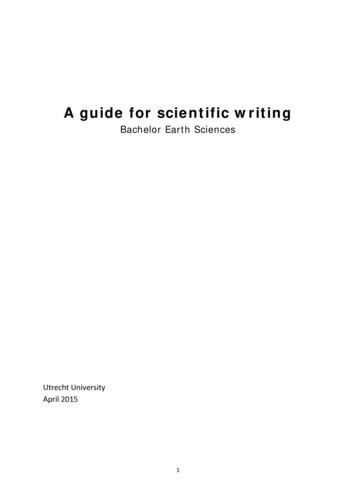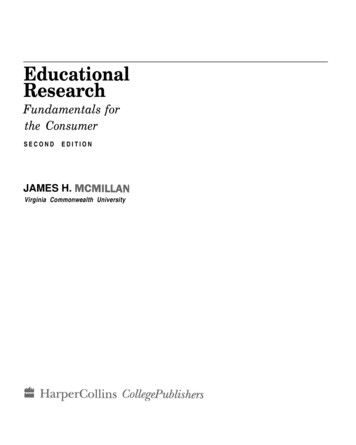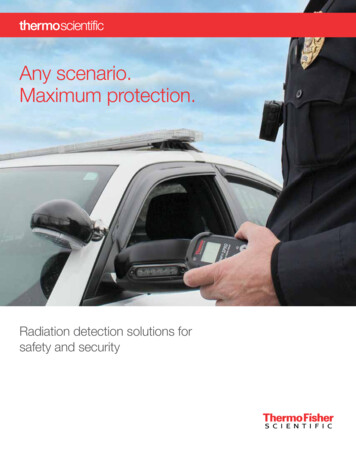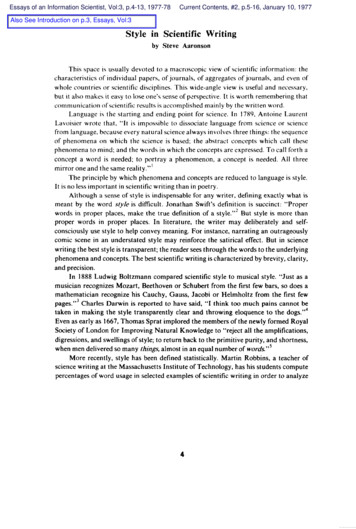
Transcription
A guide for scientific writingBachelor Earth SciencesUtrecht UniversityApril 20151
PrefaceScientific writing is an art and skill that must be learned by repetitive practice of reading,writing and revising. Throughout the bachelor’s programme of Earth Sciences, there arevarious moments during which you train your writing skills. These skills are not onlynecessary to successfully complete the final course of the bachelor programme, thebachelor thesis, but are also a prerequisite for effective communication with colleaguesor the general public in your academic or professional career.This document aims to provide concise guidelines and instructions for content, structureand style of scientific reports with examples of do’s (in green) and don’ts (in red).Scientific reports can take the form of a fieldwork report, a literature review or aresearch paper, which all share a similar basic structure. Students are encouraged to usethis document to structure and evaluate their text before submission. For teachers, thisdocument may be useful to give consistent instructions, feedback and grades. Note thatall instructions should be interpreted as guidelines and not as absolute laws; there maybe good reasons to deviate from them. In such cases, it is advised to consult yoursupervisor.This guide has been largely based on a previous version developed by the Centrum voor Onderwijsen Leren at Utrecht University (COLUU) and input and feedback from colleague lecturers andprofessors of the bachelor’s programme of Earth Science at Utrecht University.Dr Marcel van der PerkApril 20152
ContentsPreface21 Introduction41.1 Why scientific writing?41.2 Plagiarism and scientific misconduct42 Structure and content52.1 Reporting according to the IMRAD structure2.2 Other necessary content5103 Style123.1 General123.2 Structure and lay-out123.2.1 Page numbering123.2.2 Chapters and sections123.2.3 Paragraphs133.2.4 Tables and figures133.3 Literature references143.3.1 References in the body text143.3.2 Reference list163.4 General writing style173.4.1 Syntax173.4.2 Word use203.4.3 Using tenses213.4.4 Passive/active voice223.5 Spelling234 Checklist24References24Useful web pages243
1 Introduction1.1 Why scientific writing?Scientists write to communicate their research results and findings with other scientistsor experts. In this way, information is shared in a systematic manner, so thatresearchers can build upon the work of others. Although there are different ways toshare information amongst the scientific community, such as oral or poster presentationson scientific conferences, science blogs, or data warehouses, written reports, especiallythose reviewed by peer scientists and published in international journals, are still themost effective way to add your research outcomes to the body of scientific knowledge.1.2 Plagiarism and scientific misconductPlagiarism encompasses copying of someone else’s work or ideas without properreference and present it as an own piece of work. It is considered as academicmisconduct. To avoid plagiarism, do not literally copy any phrases from source materials(article, book, or report) and always give a proper reference to the original source fromwhich you borrow insights and knowledge.Scientific misconduct is broader defined as "Intention or gross negligence leading tofabrication of the scientific message or a false credit or emphasis given to a scientist"(Danish definition) and includes, besides plagiarism, data manipulation and fabrication.It should be obvious that in the academic community, any form of scientific misconductis considered to be a very serious offense and will be treated as such. More information,further explanation, and examples of fraud and plagiarism can be found on theuniversity’s website 1 or the plagiarism.org website 2.DO’sDON’T’s Write in your own words and referadequately to the literature12 Do not copy entire phrases/paragraphsfrom existing arismhttp://www.plagiarism.org/4
2 Structure and content2.1 Reporting according to the IMRAD structureScientific writing has a long tradition and since the first half of the 20th century, theIMRAD structure has become the dominant structure for scientific reports reportingoriginal research (most journal articles, congress papers, bachelor and master theses,etc.). IMRAD is an acronym for introduction, methods, results, and discussion. Thesefour elements are the main ingredients for a scientific report and are preceded by anabstract and followed by conclusions. They also usually form the main headings for thesuccessive sections of a scientific report or paper.The IMRAD structure reflects in a way the process of scientific discovery through theempirical cycle. Although the empirical cycle is often complex and involves manyiterative feedback loops (Fig. 1), the IMRAD structure seems to reduce it to anoversimplified, linear, and stepwise process. This is also why the IMRAD structure hasbeen criticised in the past for being too rigid and too simplistic (e.g. Medawar, 1964).Nevertheless, the IMRAD method has been adopted by the majority of journals across awide range of disciplines.Figure 1The empirical cycle (Understanding Science, 2015).5
The reason for its wide use and acceptance is that the IMRAD method provides a clearand logical structure that helps the reader to browse through articles more quickly tofind relevant information. Furthermore, papers and reports written according to theIMRAD method contain all required information to evaluate the quality of the researchwithout unnecessary details.DO’sDON’T’s Pursue the IMRAD structure for yourreport, thesis, or paper Do not deviate from the basic IMRADstructure without consulting yoursupervisorThe contents of each section will be further elucidated below.IntroductionIn the introduction section or chapter, you indicate what has been studied, why it hasbeen studied, and, in general terms, how it has been studied. This section contains: The background of the study and problem statement; Research question, aim of the study, or hypothesis; An outline of the approach taken.The background introduces the reader to the larger context for the specific study tounderstand why the topic is relevant, important, and thus why you have carried out youstudy. Thus, the background tells the story how you have come up with your researchquestion (see red circle in Fig. 1). It includes a literature review to make clear to whatextent the question has been addressed by others, but it should not summariseeverything that is somehow related to your topic. If a research report requires a morecomprehensive review or explanation of the theory, this could be included as a separatechapter after the introduction chapter.The background usually ends with a conclusion or problem statement that sets the scenefor your specific question. For example:“The geology of an area has a profound effect on the physiology of the landscape andsets important boundary conditions for present-day morphodynamic processes”or“Insight in the geological structure and history of the area is therefore an essentialprerequisite to understand the evolution of the present-day landscape”or“The geochronology of this formation is poorly understood”In the next paragraph, you state the research question that will be answered in yourreport. This research question should be stated in the first sentence of this paragraph.To formulate a good question, it is essential to consider the following:1. The question is important, relevant, and interesting: this should become apparent bya clear relation between the information provided in the background and yourresearch question.2. The question is simple and sufficiently specific to be answered in your study: narrowdown your question as much as possible, so that it is entirely clear what topic exactlyyou will be studying.6
3. The question is measurable: the answer can be found by measurement. Usually thatmeasurement is performed relative to something else (e.g. ‘larger than’) in thecontext of literature.4. The question is feasible: you can find an answer within the given time frame withyour resources and the facilities offered.For example:“What is the age of the . Formation?”The research question can also be formulated as a research aim or objective (e.g. “Theaim/objective of this study is to determine the age of the . Formation”) or as ahypothesis (“We hypothesise that the . Formation is of Middle Jurassic age”). In earthscience, stating a research aim is more common than stating a research question or ahypothesis.In the final paragraph of the introduction section, the common thread of the report isexplained by providing a brief description of the approach you pursued to answer theresearch question, for example what type of data you have collected (existing literaturedata, field data, laboratory analyses, experiments) and how you have processed thesedata. In a report, you may refer to the relevant chapters in which these steps are furtherelucidated. Note that this should not repeat the table of contents in your text (e.g. “Afterthis introduction, Chapter 2 describes the study area. Chapter 3 describes the materialsand methods.”).DO’sDON’T’s Formulate a relevant, simple,measurable, and feasible researchquestion Make clear to what extent the researchquestion has been addressed by others State the research question, researchaim or hypothesis in the first sentenceof a paragraph Do not sum up everything that issomehow related to your topicDo not repeat the table of contents inyour textMethodsThe methods section or chapter, sometimes called "Materials and Methods", describeshow the study was conducted. It describes the procedures that you have taken andwhich materials you used to find an answer to your research question and contains allnecessary information to repeat the study. In the methods section, you show that thedata were collected in a consistent, accurate, and accountable manner. This providesimportant information under which conditions your research outcomes have beenestablished and, thus, in which context they can be interpreted. Although the methodssection is primarily descriptive, it is also recommend to give reasons why you havechosen for the methods and materials used. The methods section may contain thefollowing subsections (if relevant):1.Study area: description of the study area (not based on own research results), forexample location, topography, geology, geomorphology, climate, vegetation. In afieldwork report, the description of the study area may also be presented as a7
2.3.4.separate chapter (usually chapter 2 after the introduction, but before the methodschapter).Field methods: description of the type of data (e.g. distance, height, thickness,direction, electrical conductivity) or samples (e.g. rock, soil, sediment, watersamples) you collected in the field and how they were collected, e.g. corings, usemeasurement devices (e.g. GPS device, ruler, compass, EC meter; providemanufacturer and device type if relevant). In the case of mapping, also describewhich parameters were mapped and which system was used (e.g. classificationsystem). Details of the sampling or observation strategy (e.g. transect sampling,observations of outcrops, random sampling, stratified sampling) should also be givenhere.Laboratory methods: description of the laboratory procedures or experiments: whichparameters were measured using which method?Data processing: description of the statistical methods you used to analyse themeasurement data.If available, also include information about the accuracy and precision of the acquireddata as long this is based on independent, existing information (e.g. literature, devicemanuals etc.). If you have examined the accuracy and precision of the data yourself aspart of your study (for example as part of a quality control), you should report only themethods here. The results of this examination should then be reported in the resultssection.DO’sDON’T’s Only describe methods that you haveused to answer your research question Do not report results from your ownstudy (for example, results with respectto your study area or precision of yourdata)ResultsIn the results section or chapter you describe the main outcomes of your study obtainedaccording to the methods section in a neutral (i.e. without interpretations that may besubject to discussion) and accessible manner. Limit yourself to only those results thatare relevant to answer your research question. It is recommended to structure thedescription of the results, for example to describe the primary features first, and thenthe secondary and tertiary features. You may also order the description of your resultsgeographically (e.g. from north to south) or chronologically (e.g. from old to young).Present the relevant results in the form figures, tables, photographs, and maps. In theaccompanying text, you elucidate the general patterns in the outcomes and give relevantquantitative information (e.g. “The upper layer is usually 2 m thicker than theapproximately 30 cm thick lower layer” or “The grain size increases with depth from 2mm near the surface to 5 cm at 1 m depth”).8
DO’sDON’T’s Only describe relevant data Structure your description (e.g. primary- secondary features; geographically) Use figures, tables, photographs, andmaps Leave out irrelevant information (e.g.touristic information or subjectiveexperiences about the fieldwork area)Do not repeat a description of themethods how you obtained your resultsDiscussionIn the discussion section or chapter, you give interpretations of your results by relatingand comparing them to each other (e.g. Do they support or contradict each other?) andput them in a broader context of the literature (e.g. what did others find that relate toyour subject?). Alternative interpretations may also be given (e.g. “The results suggest , but could also imply .”). You should also discuss the consequences of your findingsfor the aim/research question/hypothesis (e.g. do the outcome support or oppose thehypothesis? should you revise your assumptions? what information is still missing todefinitely answer your research question?; see central green circle in Fig. 1).Furthermore, you identify and discuss the implications for science (e.g. what newquestions arose from your work?; see lower right purple circle in Fig.1 ) and society (e.g.how can the new findings be used to solve societal issues or to develop newtechnology?; see lower left blue circle in Fig. 1).A persistent misconception is that the discussion section is meant to provide an overviewof all flaws and uncertainties related to your observations and findings, thereby provingthat your study is actually useless. Instead, identify and discuss what can be inferredfrom your outcomes given the flaws and uncertainties.DO’s DON’T’sDiscuss what can be inferred given theuncertainties Do not give an overview of all flaws anduncertainties proving that your study isactually uselessConclusionsIn the conclusions section you summarize the main findings and provide answers to yourresearch question. The conclusions should logically follow from your results anddiscussion. Do not present new facts or results that have not been discussed in aprevious section. Finally, draw wider conclusions regarding the implications for newquestions that arose from your study.DO’s DON’T’sSummarize your main findingsProvide answers to your researchquestions 9Do not present new facts or results
2.2 Other necessary contentTitleThe title of a paper or report reflects the content of the report and is informative andshort (approximately 15 words at maximum). Omit any redundant phrases, such as “astudy of.” or “a report of ”. For reports, a subtitle may be added. An example of anappropriate title is “Assessment of soil erosion in Africa using remote sensing”, becauseit informs the reader about 1) The subject (assessment of soil erosion), 2) the location(Africa), and 3) the research method (remote sensing).In a paper, the title is placed on top of the first page, followed by a list of authors. Inreports, the title is on the cover page. The cover page also includes the names of theauthors (and student number, if applicable), date and location of publication, name andcode of the course and supervisor (if applicable).PrefaceIn a longer research report, you may include a preface in which you the framework inwhich you carried out the study (e.g. part of your study programme or larger researchproject), acknowledgements to persons and institutes who have contributed to yourresearch (e.g. for assistance during fieldwork or laboratory analyses, for providing data,for providing of funding, or for feedback on an earlier draft of your report or paper). Thepreface is not a chapter, so it is not numbered.Table of contentsIn research reports or bachelor theses, a table of contents comes at the beginning ofyour report. It contains a list of all chapters and sections, and if applicable subsections.The chapter and section titles should be short and each title should cover the contents ofthe item concerned. The table of contents reflects the logical order of the chapters andsection and for each item, the table of contents refers to the respective page in thereport where this item starts.Furthermore, a complete list of figures and tables and a list of appendices is includedwith reference to the pages they appear. Both tables and figures are numberedconsecutively (do not use Roman numerals), but in research reports or bachelor theses itis also allowed to number the tables and figures consecutively per chapter (e.g. Figure1.1, 1.2 or Table 3.1, 3.2, .3.3, 3.4).Summary or abstractFor a fieldwork report or a bachelor thesis, a summary of about 1 page is provided at theend of your thesis. The summary briefly summarises the context, research aim orquestion, research approach (methods and materials), and main findings and conclusions(in this particular order). It should inform the reader about the highlights of your work.In a research paper, a more concise abstract is provided at beginning of your paperbefore the introduction section. An abstracts contains the same ingredients (and, ideally,the same information) as a summary, but is more concise.10
The summary or abstract is not a chapter, so it is not numbered. For both researchreports and papers, include a list of 5 key words that are related to your study. Thesekey words should be mentioned at the end of the abstract.ReferencesAt the end of the report or paper (after the conclusions section or chapter), you include areference list, in which you list all literature, to which you have referred to in your maintext. Conversely, all references in the reference list should appear in the main text. Thereference list is not a chapter, so it is not numbered. Just as the summary, the referencelist is ordered in alphabetical order. For a correct formatting of the references in themain text and in the reference list, we refer to chapter 3.AppendicesAn appendix contains materials that would obscure the structure and message of thetext if it is included in the main text. Examples include tables of all quantitative researchresults, examples of field observation forms, or computer code. All appendices should begiven an appropriate title and numbered consecutively.DO’sDON’T’s Give a short and informative title toyour workInclude references in the main text inthe reference list and vice versaInclude materials that would obscurethe structure and message of the bodytext in appendices 11Do not include redundant phrases inthe titleDo not give a chapter number to thepreface, table of contents, summary,and references
3 Style3.1 GeneralNot only the structure and content of scientific texts are important, but it is alsoessential to choose the appropriate wording, syntax, and style in your text. After all,your text should be easy to read and comprehensible, especially for your target audiencethat mainly consists of colleagues and educated laymen. This chapter provides a numberof useful tips and considerations with respect to style.In the degree programmes of Earth Science, in general we follow the style manual bythe American Society of Agronomy (ASA) 1. We refer to this document to find generalinformation about the use of abbreviations, punctuation, and units in your text. Forfurther information about the correct use of punctuation, see the Wikihow website 2 aboutthis topic.3.2 Structure and lay-out3.2.1 Page numberingYou should always insert page numbers in your document. For the body text or the entire document, use consecutive page numbers inArabic numerals at the bottom of the page. In reports, you may use a different style and page numbering for the front matter(i.e. title page, preface, table of contents) (often Roman numerals) and the bodytext (Arabic numerals). In reports, page numbers are not printed on blank pages (e.g., blank even pagespreceding a new chapter).DO’s Insert page numbers in your documentDON’T’s Do not insert page numbers on blankpages3.2.2 Chapters and sectionsThe chapters and sections reflect the global structure of a text. They often have astandard title such as “Introduction” or “Methods”, which allow readers to findinformation readily and quickly. All titles should have the same logical hierarchy. Forexample, if you describe the geological formations found in your study area, name theconsecutive sections accordingly, but do not mix up the geological formations withchronostratigrahic units or geomorphologic units either in the titles or text.Furthermore, the titles at the same hierarchical level should be formatted in the samemanner (font type and size). These styles can be defined in your word processor on-Correctly12
example, in Word: in the Style ribbon in the Home tab, such as ‘Heading1’, ‘Heading2’,‘Heading3’), which results in a consistent numbering and lay-out. Chapters, sections, and subsections should be numbered using Arabic numerals(1, 2, 3.1, 3.2, 3.3, etc.). Numbering of subsections with more than three numerals (e.g. section 4.2.3.4) isunclear and should be avoided. Alternatively, use font effects such as italics forsubsection titles to further structure your text. Non-numbered subsections shouldnot appear in the table of contents. The preface, summary, list of references are not numbered Titles do no end with a full stop.In research reports, each new chapter should start on a new page. If you print yourdocument double-sided, each chapter should start on a right page (odd page number). Ifnecessary add a blank page (even page number).DO’s Chapter and section titles have aconsistent logical hierarchyUse the same format for eachhierarchical levelChapters, sections, and subsectionsshould be numbered using ArabicnumeralsStart chapters at a new pageDON’T’s Do not make subdivide your text in toomany sections and subsections that areonly one paragraph in length3.2.3 ParagraphsParagraphs are the smaller units of a text. For clarity, it is essential that each paragraphtreats only one topic. The topic of the paragraph becomes manifest in the first or lastsentence of a paragraph. This sentence is also called the topic sentence. To establishcoherence within a paragraph, make sure that each sentence is related to this topicsentence. This can be achieved by repeating key words or phrases or using parallelstructures or linking words. These techniques are further elucidated in section 3.4.1.To start a new paragraph, indent the first line of a paragraph by about 1 cm (and do notleave a blank line between the paragraphs), but do not do this to the first line of achapter, section or subsection. This method is common in most British-English texts.Alternatively, you could start a new paragraph by leaving a blank line between theparagraphs.3.2.4 Tables and figuresAll tables, figures, photographs, and maps should be numbered consecutively in theorder as they appear and referred to in your report or paper. In papers and shortreports, number them sequentially. In longer reports, include the chapter number in thetable/figure number (e.g. Table 4-1, Table 4-2, Table 6-1; Figure 1.1, Figure 1.2, Figure3.1, etc.).13
Furthermore, note the following: Provide a caption to your table or figure. This caption should be sufficientlyinformative to understand the table or figure without reading the main text. Place the table caption above the table and the figure caption below the figure. Each table and figure should be referred to in the text. Refer explicitly to thetable/figure number. In word processors, it is advised to insert cross references,which update the table or figure numbers automatically when a new table/figureis inserted, moved or deleted. This tool is also useful for automatically generatinglists of tables and figures. Place the table or figure closely and preferably after the reference to it. Explain the symbols used in the table/figure caption or figure legend. Give units to the symbols (in the caption, in the row and column headers oftables, in the figure legend, or in the axis titles of graphs) In tables, use the symbol ‘-’ or “n/a” (not applicable) when a parameter was notdetermined If a table or figure is borrowed from the literature, provide appropriatereferences. For official publications, you may need permission from the publisherof the original table or figure. In tables, use only horizontal lines between the rows; do not use vertical lines toseparate columns. In tables, align text and numbers to the right. Provide a scale bar and orientation to maps, cross sections, and field sketches.3.3 Literature references3.3.1 References in the body textAll works that have been consulted in the production of a scientific text should beincluded in the reference list and should also be cited in the text. The style of referencingand citation differs between fields of science and publishers. Nevertheless, the style isalways consistent throughout the entire report or paper. Below you find the guidelinesfor composing citations according to the manual by the American Society of Agronomy(ASA):Journal articles In-text citations include the surname of the author and date, either both insideparentheses or with the author names in running text and the date inparentheses. For example:“Recently, Johnson (2014) has shown that” or“This has recently been shown (Johnson, 2014)” If there are two authors, name both:“This method was developed by Johnson and Smith (2012)” If there are more than two authors, use the et al. (et alii; "and others")convention:“This was based on a method introduced by Smith et al. (2002)” If more than one references are cited at one location in the text, order themchronologically in the running text separated by a comma:14
“this was discussed by Smith et al. (2002), Johnson and Smith (2012), andJohnson (2014)”or order them between brackets separated using a semicolon:“ has widely been recognised (Smith et al., 2002; Johnson and Smith, 2012;Johnson, 2014)”For citations of multiple works by the same authors in the same year, addlowercase letters (a, b, c, ) after the year. The name or names of the authorsdo not needed to be repeated, for example:“This method has been extensively applied (e.g., Murphy and Wong, 2014a,2014b; Wong, 2014)”In the unlikely case, it was impossible to trace the original publication, refer toboth the original work and the work it was cited in, for example:“According to Peterson (1873), cited by Vanderkeelen (1999)”BooksFor references to books, you should be aware of the difference between books, whichhave been written by one or more authors, and books, which have been edited by one ormore editors and which contain chapters that each have been written by one or moreauthors. In both cases you should refer to the authors who have written the relevantchapter in the same way as the reference to journal articles.Web pagesFor references to websites, also refer to author and year of publication. If the author isunknown, you could refer to the publisher instead. If the date of the website publicationis unkown, refer to n.d. (no date). For example:“Lee (2010), ASA–CSSA–SSSA (2015), Easybib (n.d.)”Do not refer directly to the URL in the running text, except in a footnote.QuotationsQuotations (literal citations) should preferably be avoided and are only very sparinglyused when it is important to know what an author has literally written. Short quotations(fewer than 40 words) are enclosed within double quotation marks. Provide the author,year, and specific page citation in the text. For example:“No Geologist worth anything is permanently bound to a desk or laboratory, but thecharming notion that true science can only be based on unbiased observation of naturein the raw is mythology.” (Gould, 1987, p.98)Quotations longer than 40 words are written in italics placed in an indented,freestanding block of text. Quotations marks are omitted. For example:No Geologist worth anything is permanently bound to a desk or laboratory, butthe charming notion that true science can only be based on unbiased observationof nature in the raw is mythology. Creative work, in geology and anywhere else,is interaction and synthesis: half-baked ideas from a bar room, rocks in the field,chains of thought from lonely walks, numbers squeezed from rocks in alaboratory, numbers from a calculator riveted to a desk, fancy equipment usuallymalfunctioning on expensive ships, cheap equipment in the human cranium,arguments before a road cut. (Gould, 1987, p.98)15
3.3.2 Reference listAll works cited in the text should appear in the reference list. Consider the followingguidelines: The references are alphabetically arranged according to th
A guide for scientific writing . Bachelor Earth Sciences . Utrecht University . April 2015. 2 . Preface . Scientific writing is an art and skill that must be learned by repetitive practice of reading, writing and revising. Throughout the bachelor’










